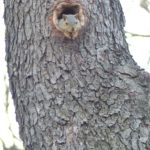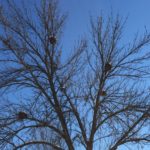Winter is the best time to spot dens and nests. Usually, we think of bird nests, and we see abandoned ones topped with mounds of snow along roadsides and in shrubs. When we look up, we also spot large clusters of leaves and sticks – squirrel nests.
Squirrels make two types of nests: dens and dreys. Dens are cavities in trees and dreys are the large balls of leaves and sticks that squirrels fashion. From the ground, these dreys look small, but they are really good sized.
Dens
When squirrel families mature in late summer, the young venture forth to find new lodgings. If the population of squirrels is low and the availability of hollows in trees is high, then squirrels take the dens. These are hollow spaces inside the trunk that squirrels line with leaves and bits of fur and bark. Squirrels do not create these hollows but use them. Wood rot and woodpeckers create the spaces and squirrels make the most of them. Dens offer great protection from the elements and predators and they are warmer. So, squirrels conserve their energy when they must “hole up” during winter storms. When the worst of the harsh weather passes, squirrels begin to stir, digging for nuts and raiding bird feeders.
Dreys
Squirrels make their dreys near sturdy forks in branches or close to the tree trunk. They will be high up for protection from predators. Usually, a tree might support one or two squirrel nests, but occasionally, we see half a dozen scattered throughout a wide-branching deciduous tree. Squirrel condominiums. These might be secondary homes or extensions of families. Secondary homes tend to be more loosely constructed and are scattered near the main home tree and serve as shelter in case a squirrel gets caught out in the elements or is being chased by a predator.
Each nest begins with a study base of twigs. Scientists have discovered that sometimes squirrels weave grapevines into the structure along with leaves, bark, moss, and twigs for added support. After all, the nest sways in the branches and get buffeted by winds, rain, and snow, so it needs to be strong. Inside, the nest is dry and warm.
When you are driving or walking look up and spot the nests of one of our most industrious small mammals. Squirrels mate in January and soon the young will be born – in the bleak mid-winter maybe in a squirrel condominium near you!




Interesting article. Hadn’t known the word drey before, but I see the nests, especially in town trees. Been watching the squirrels making ‘waves’ as they chase each other through the trees, and wondering if it’s mating season. Glad to know their nests are warm inside in this frigid weather we’re having.
Cheers
Lu
Well, on our journeys into town we see dreys high up in the tree tops. It’s curious to me that they build them so high especially since we have fierce winds that swoop down across the Blue Ridge into the flatlands. The squirrels must be very good builders which is more than I can say for some humans who skimp here and there.(: